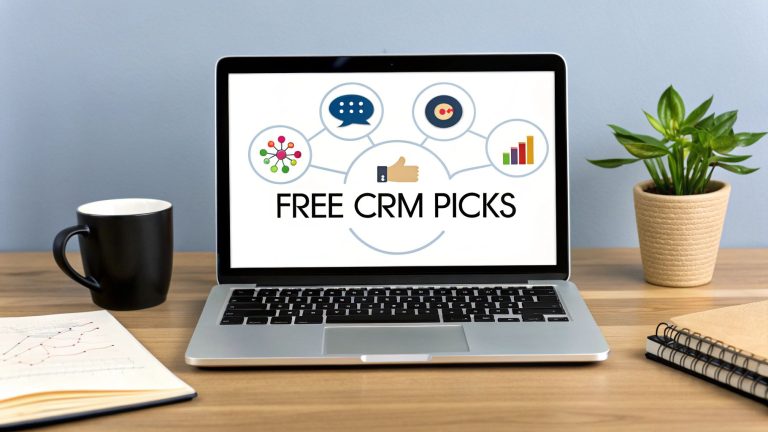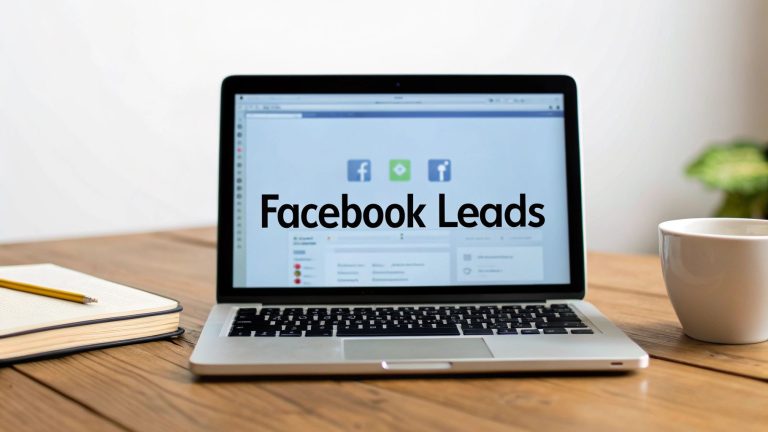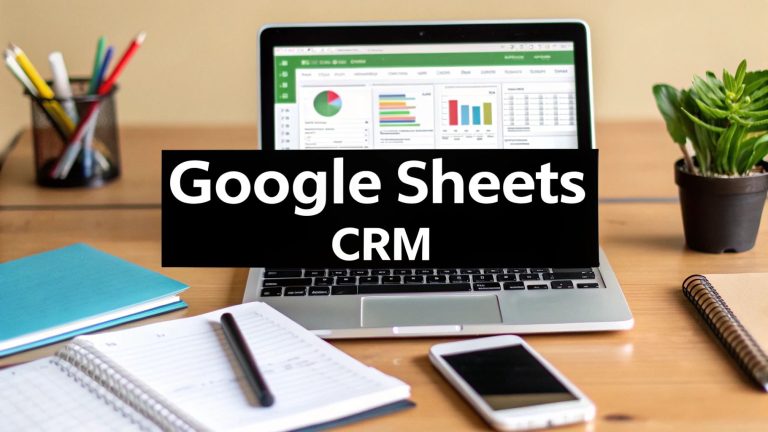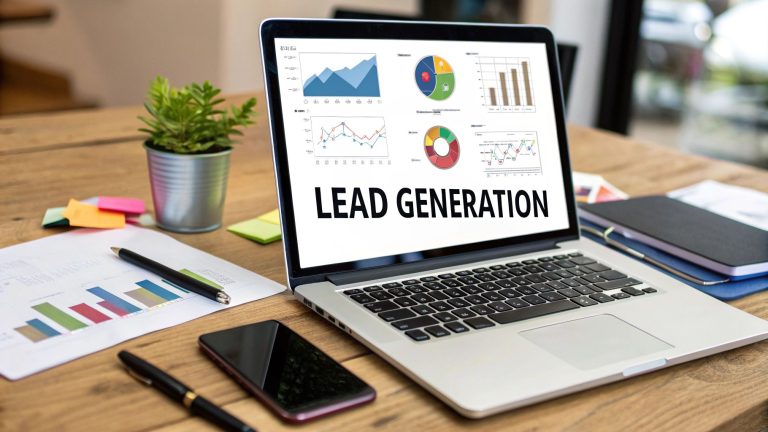How to Improve Lead Quality: Proven Strategies to Boost Conversions
If you want to get better leads from your Facebook ads, you have to make a mental shift. Stop focusing on how fast you can respond and start focusing on who you're responding to. The real wins come from prioritizing prospects who actually fit your ideal customer profile and show real buying intent, not just chasing down every single form submission.
Why Chasing Speed Over Quality Costs You Sales
For years, the sales world has been obsessed with the "speed to lead" mantra. The thinking was straightforward: the quicker you get back to someone, the better your shot at closing the deal. But in the mad dash to be first, countless sales teams burn themselves out chasing every notification, no matter how flimsy the lead is.
This approach is a recipe for wasted effort, a demoralized sales team, and surprisingly low conversion rates.
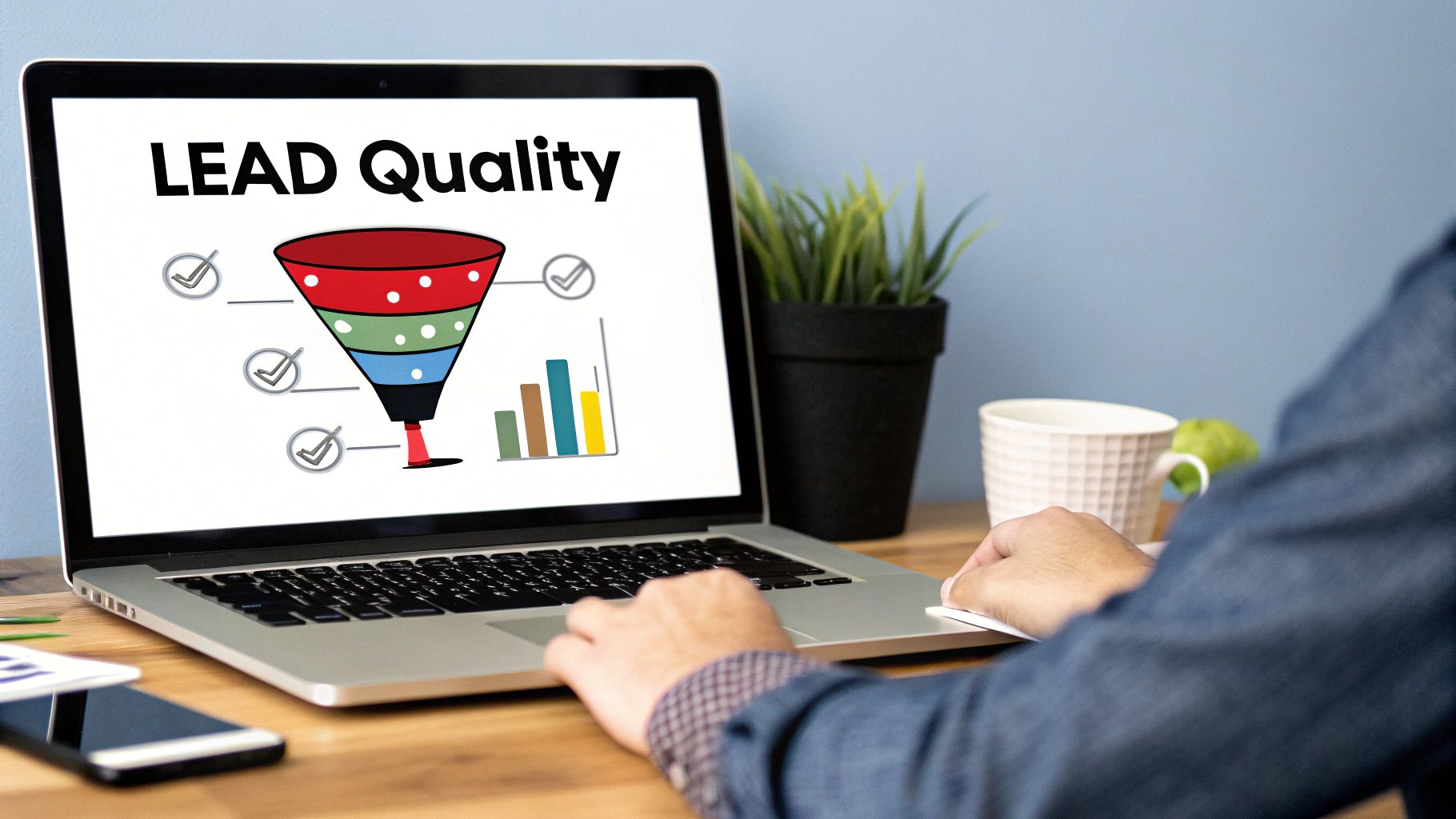
Here’s the thing: not all leads are created equal. Getting back to a high-intent prospect in minutes is a game-changer. But a lightning-fast reply to a tire-kicker? That’s just noise. It’s absolutely critical to understand why this obsession with speed can actually hurt your sales. For a great breakdown of this, check out this piece on prioritizing quality over quantity in lead generation.
The Real Impact of Response Times
And the data backs this up. An analysis of over 10 million lead interactions revealed that responding within five minutes can double or even triple conversion rates—but only if the lead is high-quality. For low-quality leads, a fast response made zero measurable difference in closing a deal.
This proves that speed is a powerful tool, but only when you apply it to the right leads.
The biggest shift in modern sales isn't about responding faster; it's about responding smarter. You have to invest your team's valuable time where it will generate the highest return. That all starts with identifying who's actually worth pursuing.
A Real-World B2B SaaS Scenario
I once worked with a B2B SaaS company that was completely fixated on a sub-five-minute response time for every single Facebook lead. Their sales development reps (SDRs) were totally swamped, spending their days calling students, competitors, and other unqualified prospects who had simply downloaded a free guide.
Team morale was in the gutter, and their lead-to-demo conversion rate was a painful 3%.
So, they decided to pivot. Instead of scrambling to call everyone instantly, they put a qualification-first system in place using smarter forms and a simple lead scoring model.
Here’s what they did:
- Initial Filter: They added a field to their forms that required a company email address. No more Gmail or Yahoo submissions.
- Scoring: Leads from their target industries with more than 50 employees were automatically flagged as “high-priority.”
- Workflow: Only these high-priority leads got an immediate call from an SDR. Everyone else was automatically added to a targeted email nurture sequence.
The results were incredible. The total number of calls the SDR team made dropped by 60%, but their lead-to-demo conversion rate shot up to 15%.
By focusing on quality, they reduced burnout and had far more meaningful sales conversations. This just goes to show that figuring out what a quality lead looks like for your business is the most important first step you can take.
Refining Your Audience Targeting for Higher Intent
Getting high-quality leads isn't about casting the widest net you can. It's about fishing in the right ponds with the right bait. Precise audience targeting is where you finally separate the high-intent prospects from the window shoppers, and it goes way beyond just tinkering with age and location.

To really boost your lead quality, you need to attract people who aren't just a good fit on paper, but who are actively showing signs they're ready to buy. That means digging into the more powerful features that platforms like Facebook offer. Once you’ve got a crystal-clear picture of your ideal customer, the next move is mastering audience targeting on platforms like Facebook.
Go Beyond Basic Lookalike Audiences
Lookalike Audiences are a fantastic tool, but there’s a common mistake I see all the time: businesses build them from their entire lead database. That list is almost always cluttered with tire-kickers and unqualified folks, which just tells Facebook to go out and find more people exactly like them. Not good.
Instead, you should be creating a High-Value Customer Lookalike Audience. Take the time to export a list of only your absolute best customers—think highest lifetime value, fastest converters, or repeat buyers. Use that curated list as your source. This simple switch trains the algorithm to hunt for prospects who share traits with the people who already love what you do, instantly upgrading the quality of your incoming leads.
Pro Tip: Don't just stop at one high-value list. Try creating separate Lookalike Audiences from different customer segments. For instance, you could have one for your top-tier clients and another for customers who bought a specific high-margin service. Test them against each other to see which one brings in the best results.
Layer Interests and Behaviors for Intent
This is where the real magic happens. When you start layering your targeting options, you filter out the casual scrollers and lock in on users who are showing genuine interest. The key is to use “AND” logic—not just adding more and more interests to your audience pool, which only makes it broader.
Think of it as building a super-specific profile. You’re not just targeting someone interested in "Real Estate." You’re targeting someone interested in "Real Estate" AND "Mortgage calculators" AND "First-time home buyer grants." Every single layer you add acts as a powerful qualifier that screams higher intent.
Example Scenario: A Local Real Estate Agency
I once worked with a real estate agency that was getting buried in leads from people just casually browsing Zillow. They needed to connect with serious first-time homebuyers, not dreamers.
- Their Old Targeting (Low Quality): People interested in Real Estate, Zillow, OR Home Improvement. The audience was way too broad.
- Our New Layered Targeting (High Quality):
- Layer 1 (Behavior): People that Facebook classified as "Likely to Move."
- Layer 2 (Interest): AND who were also interested in "Mortgage calculators."
- Layer 3 (Interest): AND who were also interested in "First-time home buyer grants."
By creating this highly specific, layered audience, the agency's ads were suddenly being shown only to people who were exhibiting multiple signs of being in the active buying process. This one strategic shift slashed their cost per qualified lead by a massive 40%.
These advanced targeting methods take a bit more thought upfront, but they are absolutely fundamental to improving lead quality. And once you have these better prospects flowing in, you can start exploring how tools for auto lead generation help you engage them effectively from the very first second.
Designing Lead Forms That Weed Out Bad Leads
Your lead form is the front door to your sales pipeline. If that door is wide open with no lock, you’re inviting in a flood of spam, low-intent browsers, and people who will never buy from you. But if you make it too complicated—like a bank vault—you’ll scare away even your best potential customers.
The secret to better lead quality isn't about volume; it's about friction. Think of your form as your first line of defense. Every field you add creates a tiny bit of resistance. While too much is a deal-breaker, the right amount is exactly what you need to filter out those who aren't serious. It’s a classic trade-off: a slightly smaller number of leads for a much higher concentration of real opportunities.
Add Strategic Qualifying Questions
The fastest way to improve quality is to ask questions that only a legitimate prospect can—or would bother to—answer. Moving beyond just "Name" and "Email" is non-negotiable. For instance, simply adding a "Company Name" or asking for a "Work Email" field can dramatically cut down on submissions from casual users and bots.
Consider adding a few more fields that reveal true intent and help you qualify on the spot:
- Company Size: This helps you segment leads and focus on businesses that fit your ideal customer profile.
- Job Title: Are you talking to an intern or a decision-maker? This field tells you instantly.
- Budget Range: A powerful qualifier. It immediately separates the serious buyers from the window shoppers.
- Biggest Challenge: This open-ended question is gold. It gives your sales team the exact context they need to start a meaningful conversation.
For a deeper dive into crafting effective forms, check out these lead capture form best practices. You’d be surprised how a few small tweaks can transform the quality of your inbound leads.
The goal is to thoughtfully add fields that matter. I've seen clients go from a 2-field form to a 5-field form and, while their lead count dropped by 20%, their qualified lead rate shot up by 50%. They spent less time chasing dead ends and more time closing deals.
To help you decide, here’s a quick breakdown of how different fields typically perform.
Impact of Form Fields on Lead Volume and Quality
| Form Field | Impact on Lead Volume | Impact on Lead Quality | Best Use Case |
|---|---|---|---|
| Name & Email | Highest | Lowest | Top-of-funnel content like a free newsletter or a basic guide. |
| Work Email | High | Medium | Filtering out personal inquiries; great for B2B offers. |
| Company Name | High | Medium | A simple way to qualify B2B leads without much friction. |
| Phone Number | Medium | High | For bottom-of-funnel offers where immediate follow-up is critical. |
| Job Title | Medium | High | Ensuring you're reaching decision-makers or key influencers. |
| Budget Range | Low | Highest | Qualifying high-intent leads for sales calls or demos. |
| Custom Question | Low | Highest | Gathering specific context for a highly personalized follow-up. |
As you can see, it's all about matching the form to the offer. Don't ask for a budget on a simple ebook download, but don't be afraid to ask for it when someone requests a demo.
Use Conditional Logic for a Smarter Flow
Adding more fields doesn't mean you have to present users with a giant, intimidating form. This is where conditional logic is a game-changer. It lets you build dynamic forms that show or hide questions based on a user's answers.
For example, if a prospect selects "Marketing Manager" as their job title, you can display a follow-up question asking about their team's top marketing goal. If they choose "Student," you can simply end the form or guide them toward educational resources instead. This creates a tailored experience, gathering rich data from high-value prospects while keeping it simple for everyone else.
The goal isn't just to make the form longer; it's to make it smarter. You want to create just enough thoughtful friction to deter low-effort submissions while simultaneously gathering the critical data needed for effective lead scoring and qualification.
This isn’t just theory. The data speaks for itself.
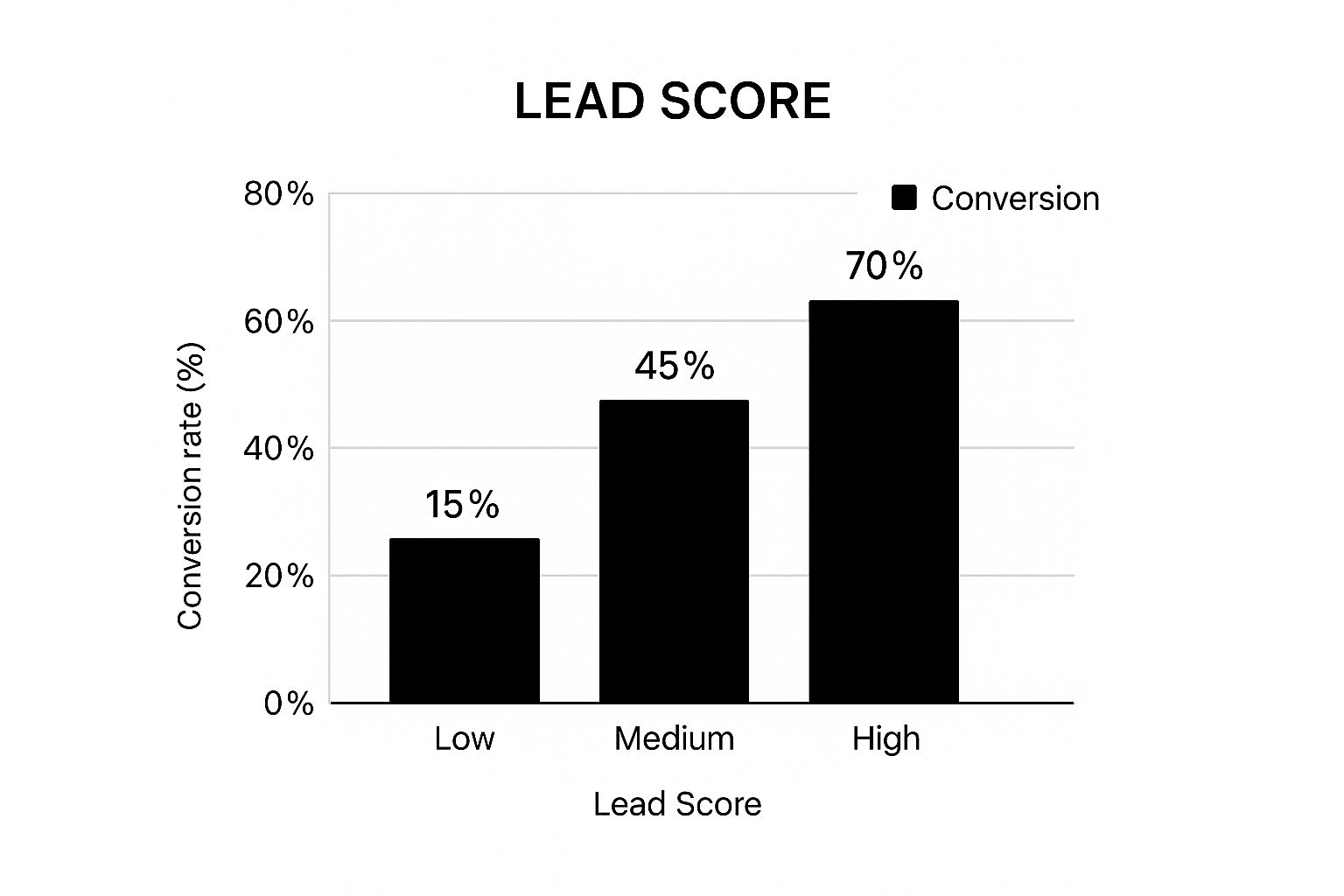
As you can see, leads that are properly qualified with good form data convert at a much higher rate. In this case, high-quality leads convert at more than four times the rate of low-quality ones. That’s the direct result of a well-designed form doing its job.
Using AI for Smarter Lead Scoring and Qualification
Let's be honest: manually reviewing every lead that comes in isn't just slow—it's broken. Human bias, a long day, or just plain fatigue can cause your sales team to chase the wrong people while genuinely hot leads go cold. This is exactly where AI stops being a buzzword and starts becoming your most valuable player for boosting lead quality.
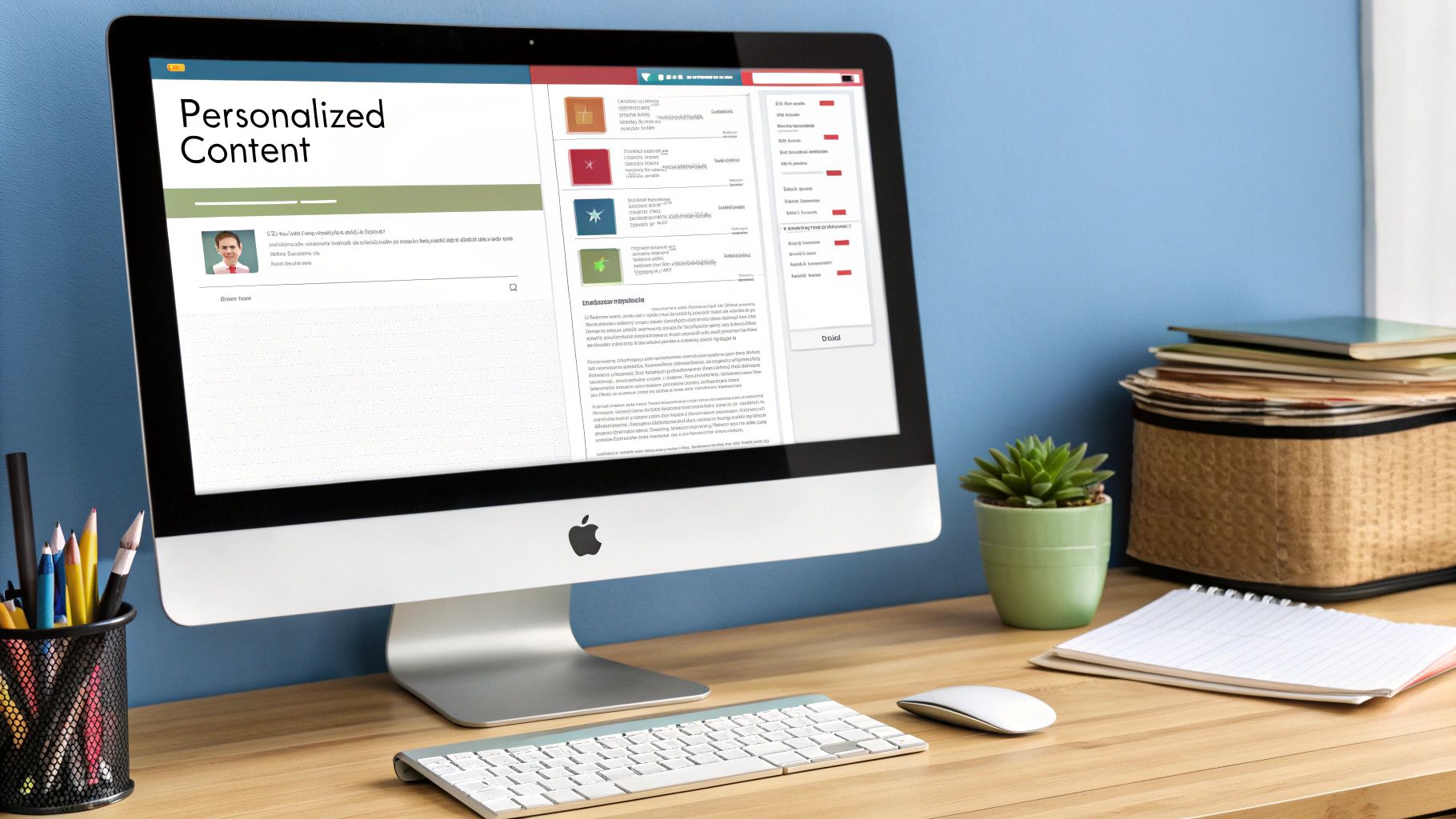
AI-powered lead scoring changes the entire game. Instead of just looking at the surface-level info from a form, it digs deeper. It analyzes behavioral signals, engagement patterns, and company details to predict a lead's buying intent with startling accuracy. You stop guessing based on a job title and start knowing how likely they are to actually sign a check.
This isn't just a small tweak; it’s a fundamental shift for B2B qualification. In fact, we’ve seen AI-driven scoring systems improve qualification accuracy by around 40%. Businesses that adopt these tools often report conversion rates climbing by as much as 35%, simply because their sales teams are finally focused on prospects with real intent.
How to Build Your AI-Powered Scoring Model
Setting up a smart scoring model is more straightforward than you might think. It really just starts with defining what an ideal lead looks like for your business. From there, you assign point values to different attributes and actions, creating a system that automatically qualifies (or disqualifies) leads as they arrive.
A solid model usually pulls from a mix of data points:
- Demographic/Firmographic Data: Assign points for things that match your ideal customer profile, like specific job titles, company sizes, or industries.
- Engagement Data: These are your high-value actions. Someone visiting your pricing page, downloading a case study, or watching a webinar should get a big point boost.
- Negative Scoring: Just as important is knowing who not to chase. Subtract points for actions like using a generic Gmail address or having an irrelevant job title like "Student."
The whole idea is simple: the higher the score, the hotter the lead. This automated ranking ensures your sales team invests their time talking to prospects who are already halfway to the finish line, not stuck at the starting block.
Defining Your MQL and SQL Thresholds
Once your scoring system is in place, the next crucial step is setting clear thresholds. This is how you define what makes a lead a Marketing Qualified Lead (MQL) versus a Sales Qualified Lead (SQL), creating a seamless handoff between your teams.
Here’s a common approach:
- Marketing Qualified Lead (MQL): This is a lead who hits a baseline score (say, 50 points). They’re a good fit and are ready for more nurturing from marketing, but not quite ready for a sales call.
- Sales Qualified Lead (SQL): This lead is on fire. They’ve hit a high score (maybe 100+ points) or have taken a high-intent action like requesting a demo. These get flagged for immediate, personal follow-up from sales.
This data-first approach removes all the guesswork. Better yet, a tool like LeadSavvy Pro can automate this entire workflow. It syncs lead scores and all their data directly into your CRM or a simple Google Sheet in real-time. This completely frees your sales team from manual list-checking and lets them do what they do best: closing deals with the hottest prospects.
If you want to dig even deeper into how AI can streamline your entire process, this ultimate guide to AI chatbots is a great resource.
Building a Nurturing Workflow That Actually Converts
Let's be real for a second. A high-quality lead isn't always a sales-ready lead.
In fact, some of your absolute best prospects—the ones who perfectly fit your ideal customer profile—just aren't ready to pull out their credit card the moment they fill out your form. Treating these leads as dead ends is a colossal waste of marketing spend. It's one of the biggest missed opportunities I see.
The solution isn't to toss them aside; it's to guide them. An effective lead nurturing workflow builds a relationship over time, turning that initial flicker of interest into genuine trust and, eventually, a sale. It’s all about playing the long game with prospects who have shown they have potential but just need a bit more time and information.
Segment Your Nurture Sequences
A one-size-fits-all email sequence is a recipe for failure. The way you talk to someone who downloaded a top-of-funnel whitepaper should be drastically different from how you engage a prospect who asked for a demo. This is where most people get it wrong.
Segmenting your nurturing based on the lead's first action is critical.
- For 'Whitepaper Download' Leads: Their journey is just getting started. Your goal here is education, not a hard sell. Send them a sequence that gives them more value, like a link to a related blog post, a customer case study, or an invite to a free webinar.
- For 'Demo Request' Leads: These are your hot leads. Your sequence should be all about reinforcing their decision and getting them prepped for the sales call. Send a confirmation email, a quick overview of what the demo will cover, and links to a few powerful testimonials.
This simple, segmented approach shows you’re paying attention to their needs and not just spamming them with generic marketing. It's a small change that can make a massive difference in your engagement rates.
The Power of a Value-First Approach
The data backs this up, big time. Companies with strong lead nurturing systems generate 50% more sales-ready leads while slashing acquisition costs by 33%. Even better, nurtured leads tend to make bigger purchases—spending 47% more than leads who aren't nurtured. You can discover more insights on these powerful sales statistics to see the full picture for yourself.
The core principle is simple: give before you ask. Your goal is to become a trusted resource, not just another vendor in their inbox. When the time comes for them to finally buy, you’ll be the first one they think of.
This is where automation becomes your best friend. Manually tracking and emailing every single lead is impossible once you start getting any kind of volume. A simple, automated 5-email sequence can work wonders, re-engaging prospects who would have otherwise gone completely cold. For more on this, check out our guide on automated lead nurturing to see exactly how to set this up.
An Example Nurture Workflow
Imagine a lead downloads your "Ultimate Guide to Facebook Ads." Here’s a simple but incredibly effective 5-email workflow you can automate with a tool like LeadSavvy Pro:
- Email 1 (Instant): Deliver the guide immediately with a warm welcome.
- Email 2 (Day 3): Share a related blog post, like "5 Common Facebook Ad Mistakes to Avoid."
- Email 3 (Day 7): Send a short, punchy case study showing how a similar company got amazing results.
- Email 4 (Day 12): Invite them to a free webinar you're hosting on advanced ad targeting.
- Email 5 (Day 18): Make a soft offer. Introduce your product or service as the logical solution to the challenges you've been discussing.
This workflow systematically builds trust and educates the prospect. By the end, the final sales pitch feels natural and helpful, not abrupt and pushy. This is exactly how you transform a good lead into a great customer.
We Get These Questions About Lead Quality All The Time
When you start digging into how to get better leads, the same questions pop up again and again. Let's tackle them head-on with some straight-to-the-point answers that you can actually use.
What Really Is a Quality Lead?
Forget about just collecting names and emails. A quality lead is a real person who fits your ideal customer profile (ICP), is genuinely looking for a solution like yours, and is very likely to become a paying customer. It’s all about relevance and intent, not just a row in a spreadsheet.
For instance, a marketing manager at a 100-person tech company who downloads your pricing guide? That’s a quality lead. A student who grabbed a free template for a class project? Not so much, even with a valid email. Understanding this distinction is ground zero for improving your entire lead generation strategy.
How Do I Know if My Lead Quality Is Actually Getting Better?
You have to look beyond the initial form submission. While there isn't a single "quality score" you can look at, you can track a few key performance indicators that tell the whole story.
Stop obsessing over Cost Per Lead (CPL) and start paying attention to the metrics that show you’re making real progress:
- Lead-to-Meeting Rate: What percentage of leads are actually booking a call with your sales team? If this number is going up, you're attracting people who are ready to talk.
- Conversion Rate to Pipeline: How many of those leads turn into legitimate sales opportunities? This metric connects your marketing efforts directly to revenue.
- Sales Cycle Length: High-quality leads are often better informed and more motivated, which means they tend to close faster. A shorter sales cycle is a huge win.
If you see these numbers improving, you know your targeting and form optimizations are working.
The most important mental shift is moving from measuring lead volume to measuring lead velocity. A small handful of leads that fly through your sales funnel is always better than a massive list of duds who go nowhere.
What's the Single Most Impactful Thing I Can Do First?
If you do just one thing, make it this: add strategic qualifying questions to your lead forms. Seriously. This is your first line of defense, and it’s the easiest change you can make for an immediate impact.
Instead of just asking for a name and email, add one or two fields that make a prospect reveal their intent. For a B2B business, simply requiring a "Work Email" or "Company Name" is a game-changer. That tiny bit of friction is often enough to scare away low-intent browsers and instantly improve the quality of every lead that comes through.
It’s the foundational move for any company that wants to stop wasting time and money and start having more valuable sales conversations.
Ready to stop downloading CSVs and start engaging your best leads faster? LeadSavvy Pro automates the entire process, sending your Facebook leads directly to your favorite tools in real-time. Sign up for a free plan and see how it works!



